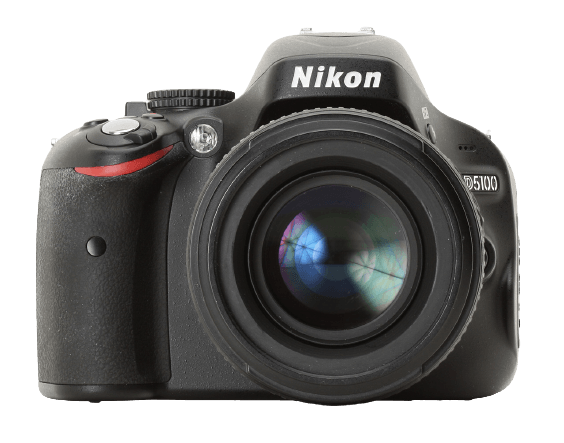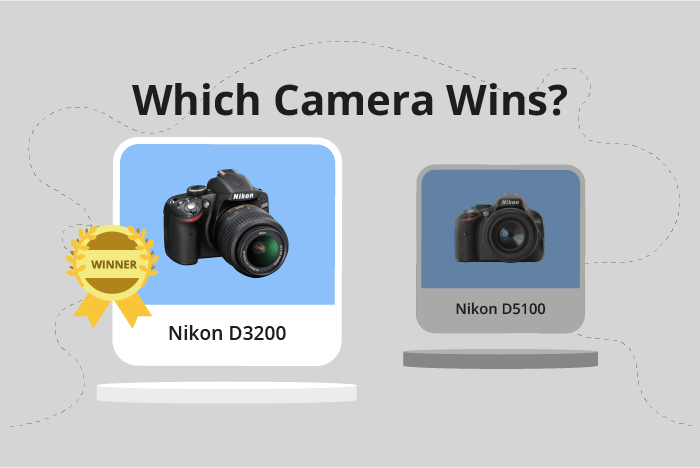Nikon D3200 vs D5100 Comparison
Nikon D3200

Nikon D5100

The Nikon D3200 outperforms the Nikon D5100, scoring 54/100 compared to 49/100. Both cameras share similarities as DSLR cameras, released in 2012 and 2011 respectively, with launch prices of $699 (D3200) and $799 (D5100). Additionally, their sizes are relatively close, with the D3200 measuring 125 x 96 x 77mm and the D5100 at 128 x 97 x 79mm.
The D3200’s higher score reflects its superior features, such as a lighter weight at 505g compared to the D5100’s 560g. However, the D5100 has its advantages, such as a slightly larger body which may offer better grip for some users.
Both cameras have their strengths and weaknesses, but the Nikon D3200 ultimately stands out as the better option due to its higher score and more favorable specifications.
Nikon D3200 vs D5100 Overview and Optics
The Nikon D3200 outperforms the Nikon D5100 in optics with a score of 63/100, compared to the D5100’s 52/100. Both cameras share several similar specifications, including a 4 fps shooting speed, CMOS sensor type, APS-C sensor size, Nikon F DX lens mount, and lack of image stabilization.
The D3200’s superiority in optics is attributed to its 24.2-megapixel resolution, higher than the D5100’s 16.2 megapixels. This difference allows the D3200 to capture more detailed and sharper images. Additionally, the D3200 features the Expeed 3 processor, which is more advanced than the D5100’s Expeed 2 processor. This results in better image processing and overall performance. Furthermore, the D3200 has a slightly higher DXOMARK sensor score of 81, compared to the D5100’s 80, indicating better overall sensor quality.
On the other hand, the D5100 has some advantages over the D3200. Its lower megapixel count may result in larger pixels on the sensor, potentially providing better low-light performance and a higher dynamic range. However, this advantage is minimal, as both cameras have nearly identical DXOMARK sensor scores.
Ultimately, the Nikon D3200 is the better choice in terms of optics, with its higher megapixel count and more advanced processor. The Nikon D5100, while still a capable camera, falls short in comparison, with its only advantage being a potential, yet minimal, improvement in low-light performance and dynamic range. Both cameras cater to the needs of photographers, but those prioritizing image quality and detail should opt for the Nikon D3200.
Nikon D3200 vs D5100 Video Performance
The Nikon D3200 has a video score of 43 in comparison to the 5100’s 57. Both cameras allows users to record videos in Full HD, with a maximum resolution of 1920 x 1080. The highest video frame rate available is 30 frames per second. However, the Nikon D3200 does not have built-in time-lapse functionality, giving the D5100 an edge.
Nikon D3200 vs D5100 Features and Benefits
The Nikon D5100 wins the feature comparison with a score of 43/100, slightly surpassing the Nikon D3200’s score of 41/100. Both cameras share several specifications, including a 3-inch screen size and a screen resolution of 921,000 dots. Neither camera has a touchscreen, GPS, WiFi, or Bluetooth capabilities.
The Nikon D5100 stands out due to its flip screen feature, which the Nikon D3200 lacks. This flip screen allows for more versatility in shooting angles and can be especially useful for capturing images from challenging perspectives or when recording video content.
On the other hand, the Nikon D3200 does not offer any additional features that make it superior to the Nikon D5100. Both cameras have the same screen size and resolution and lack the same connectivity features. The only advantage the Nikon D3200 has over the Nikon D5100 is its slightly lower score, which could potentially indicate a lower price point or older release date, depending on the buyer’s preferences.
In comparing the features of the Nikon D3200 and Nikon D5100, the D5100 emerges as the better option due to its flip screen. The D3200 does not offer any unique features that make it a more attractive choice. While both cameras share many similarities, the flip screen on the D5100 provides an added benefit for photographers seeking more flexibility in their shooting experience.
Nikon D3200 vs D5100 Storage and Battery
The Nikon D5100 wins in the storage and battery category with a score of 51/100, while the Nikon D3200 scores 27/100. Both cameras share common specifications in this area, such as having a single memory card slot, accepting SD/SDHC/SDXC memory cards, using the same EN-EL14 battery type, and lacking USB charging capability.
The D5100 outperforms the D3200 in battery life, offering an impressive 2200 shots compared to the D3200’s 540 shots. This significant difference makes the D5100 a more reliable choice for extended shooting sessions without needing frequent battery replacements or charging.
The D3200, however, does not have any advantages in the storage and battery category over the D5100. The inferior battery life and similar storage options make it a less appealing option compared to its counterpart.
Taking these factors into consideration, the Nikon D5100 emerges as a clear winner in the storage and battery department. The longer battery life and shared storage capabilities make it a more practical and reliable choice for photographers seeking extended shooting capabilities.
Alternatives to the Nikon D3200 and D5100
Are you still undecided about which camera is right for you? Have a look at these popular comparisons that feature the Nikon D3200 or the Nikon D5100:

